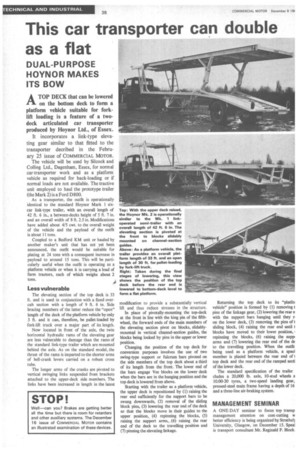This car transporter can double as a flat
Page 40

If you've noticed an error in this article please click here to report it so we can fix it.
DUAL-PURPOSE HOYNOR MAKES ITS BOW
ATOP DECK that can be lowered on the bottom deck to form a platform vehicle suitable for forklift loading is a feature of a twodeck articulated car transporter produced by Hoynor Ltd., of Essex.
It incorporates a link-type elevating gear similar to that fitted to the transporter decribed in the Febru ary 25 issue of COMMERCIAL MOTOR.
The vehicle will be used by Silcock and Coiling Ltd., Dagenham, Essex, for normal car-transporter work and as a platform vehicle as required for back-loading or if normal loads are not available. The tractive unit employed to haul the prototype trailer (the Mark 2) is a Ford D800.
As a transporter, the outfit is operationally identical to the standard Hoynor Mark 1 sixcar link-type trailer, with an overall length of 42 ft. 6 in., a between-decks height of 5 ft. 7 in and an overall width of 8 ft. 2.5 in. Modifications have added about 4/5 cwt. to the overall weight of the vehicle and the payload of the outfit is about II tons.
Coupled to a Bedford KM unit or hauled by another maker's unit that has not yet been announced, the outfit would be suitable for plating at 24 tons with a consequent increase in payload to around 15 tons. This will be particularly useful when the outfit is operating as a platform vehicle or when it is carrying a load of farm tractors, each of which weighs about 2 tons.
Less vulnerable
The elevating section of the top deck is 33 ft. and is used in conjunction with a fixed overcab section with a length of 9 ft. 6 in. Side bracing members of the latter reduce the "open" length of the deck of the platform vehicle by only 3 ft. and it can, therefore, be pallet-loaded by fork-lift truck over a major part of its length.
Now located in front of the axle, the twin horizontal hydraulic rams of the elevating gear are less vulnerable to damage than the rams of the standard link-type trailer which are mounted behind the axle. As on the standard model, the thrust of the rams is imparted to the shorter arms of bell-crank levers carried on a robust cross tube.
The longer arms of the cranks are pivoted to vertical swinging links suspended from brackets attached to the upper-deck side members. The links have been increased in length in the latest modification to provide a substantially vertical lift and thus reduce stresses in the structure.
In place of pivotally-mounting the top-deck at the front in line with the king pin of the fifthwheel, the forward ends of the main members of the elevating section pivot on blocks, sfidablymounted in vertical channel-section guides, the blocks being locked by pins in the upper or lower position.
Changing the position of the top deck for conversion purposes involves the use of two swing-type support or fulcrum bars pivoted on the side members of the top deck about a third of its length from the front. The lower end of the bars engage Vee blocks on the lower deck when the bars are in the hanging position and the top deck is lowered from above.
Starting with the trailer as a platform vehicle, the upper deck is repositioned by (1) raising the rear end sufficiently for the support bars to be swung downwards, (2) removal of the sliding block pins, (3) lowering the rear end of the deck so that the blocks move in their guides to the upper position„ (4) repinning the blocks, (5) raising the support arms,. (6) raising the rear end of the deck to the travelling position and (7) pinning the elevating linkage. Returning the top deck to its "platfoi vehicle" position is formed by (1) removing pins of the linkage gear, (2) lowering the rear e with the support bars hanging until they n on the lower deck, (3) removing the pins of I sliding block, (4) raising the rear end until blocks have moved to their lower position, 1 repinning the blocks, (6) raising the supp arms and (7) lowering the rear end of the de to the travelling position. When the outfit being used as a platform vehicle, a spaci member is placed between the rear end of 1 top deck and the rear end of the ramped secti of the lower deck.
The standard specification of the trailer eludes a 20,000 lb. axle, 10-stud wheels a 10.00-20 tyres, a two-speed landing gear, pressed-steel main frame having a depth of 16 and a three-line air-braking system.
MANAGEMENT SEMINAR A ONE-DAY seminar to focus top transp management attention on cost-cutting w better efficiency is being organized by Strathel3 University, Glasgow, on December 15. Speal is transport consultant Mr. Reginald P. Block.












































































































